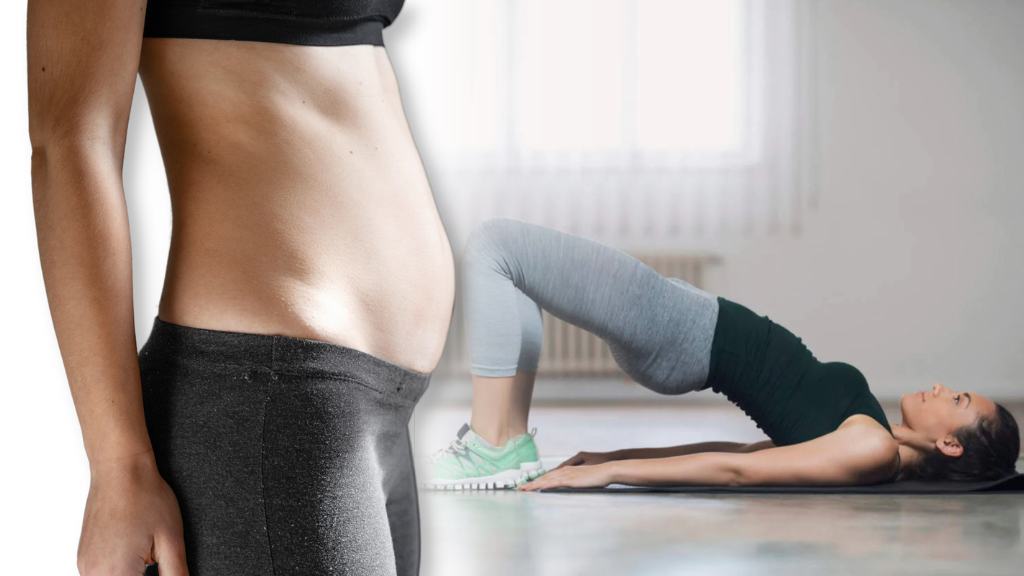
Table of Contents
The separation of the right and left abdominal muscles in the midline of the abdomen is known as a diastasis recti. You get this condition if your abs are separated more than 2 cm. Diastasis recti are also frequently called the “mom pooch” or the “lower belly pooch.” Up to 66% of pregnant women will suffer diastasis recti by the third trimester.
Symptoms of Diastasis Recti
So how would you figure out if you have diastasis recti? Check out for these signs:
- Lower back pain
- Bowel or urinary issues
- Poor posture
- Difficulty while performing these actions
- Climbing stairs
- Walking
- Squatting
- Lifting
- Reaching
- Bending
7 Exercises for Diastasis Recti
The first two diastasis recti exercises focus on positioning the spine neutrality with the pelvic and transverse abdominal muscles. As you read, you will find out which of the seven exercises for diastasis recti is meant to target which area of your abdomen and pelvis.
1. Pelvic Brace
The pelvic brace helps you find a neutral spine and prepares your deep core muscles. Follow these steps to ace the pelvic brace exercise:
- Your feet must lie flat on the floor, and your knees should really be bent.
- Put your hands over the top of your pelvis with the heel of your hands over the front bones of your pelvis, sometimes referred to as the “hips”.
- Put your fingers over your pubic bone. By doing this, you are forming a triangle, and if your pelvis is in a neutral posture, all three points should be level.
- Perform a pelvic floor muscular contraction while exhaling (aka Kegel). Your muscles should start to tighten from the rear to the front. The anus, vagina, and urethra should feel like they are the first openings to close throughout this process.
- Gently tighten your lower abdominal muscles while you contract as if you were moving your navel closer to your spine. Maintain neutral pelvic alignment throughout the exercise. Hold this alignment for at least 3 seconds.
Perform this exercise fifteen times, one to two times daily.
2. Closing The Gap
This exercise paraphrased as neuromuscular education, trains your rectus abdominis muscles to go toward the midline. So how do you close the gap with this diastasis recti exercise?
- Lie on the ground with your feet flat on the floor, and bend your knees.
- Cross a towel or sheet in front of you and wrap it over your waist. Grab something with your palms facing you. Prepare for the movement by taking a breath.
- Lift your head as you exhale and tighten the towel around yourself (or your head and shoulders if you can).
- Pressing your lower back into the floor can help to further engage your rectus abdominis as you stand up.
- After taking a breath, untuck your hips, bring your lower back to neutral, and place your head back on the mat.
Breathe out and repeat the set twice but keep a note of any neck complaints. Perform two sets of 10 to 20 repetitions one to two times every day.
The following 3 exercises focus on creating tension at the abdominal midline to reduce the bulge.
3. Chair Position
The chair position is one of the exercises for diastasis recti that assists in increasing the endurance of your core. For this exercise
- Lay on your back with a chair under your calves to support your hips and knees at a 90-degree angle.
- Obtain the neutral pelvic posture that is described in exercise one (pelvic brace).
- Inhale and exhale to stabilize your pelvis for movement as you lift your calves off the chair.
- Hold for at least 10 seconds, but pause if you feel any discomfort on your back.
There shouldn’t be any doming or bulging of your abdominal muscles as you lift your legs off the floor. Repeat this set at least ten times. Perform this workout one to four times each week, depending on your schedule. The objective is to gradually extend your hold period while keeping your abs tight with each inhalation and exhalation. Eventually, you should be able to work up to three sets of one-minute holds.
4. Toe Dips
The transverse and rectus abdominis, as well as the obliques and hips, are activated during toe dips (also known as toe taps). To do the perfect toe dip
- Lie on flat ground.
- Bend your knees with your pelvis in a neutral position as if you are sitting on an imaginary chair.
- Keep your hands at your side.
- Inhale and prepare yourself for the movement.
- Exhale as you raise your head (with or without your shoulder blades). Inhale and hold your posture.
- Exhale while keeping your right knee bent and dip your toe towards the floor.
- Inhale as you bring your right toe and knee back to the chair position.
- Exhale and repeat the last two steps with your left leg.
Repeat 10–15 toe taps or toe dips on each side and watch out for any abdominal doming or bulging. Schedule at least 3 to 4 days for this exercise every week.
5. Bird Dog
The deep core muscles, such as the glutes, lower back, and abdominal muscles, are strengthened with this diastasis recti exercise. You need to keep your spine neutral and brace your pelvis throughout this routine. Here’s what you need to do:
- Get on the floor on your knees and hands. Remember to maintain a neutral spine.
- Inhale to begin the exercise.
- Exhale and lift your right leg and left arm. Make sure your spine is neutral and your pelvis is braced.
- Inhale and do a squat.
- Exhale and raise your right arm and leg.
Make sure there is no doming or bulging in your abdomen while you repeat this exercise 10-15 times on each side, three to four times a week.
6. Transverse Abdominal Breathing
The pelvic floor muscles and deep transverse abdominal muscles (TVA) support the inter-abdominal pressure system, your internal organs, and the stability and mobility of your lower spine. For this diastasis recti exercise you want your whole motion to originate just from your belly.
- Inhale and hold your breath for a second.
- Exhale for 5 seconds.
- Pull your belly button down toward the mat while you exhale.
In the exhaled stance, concentrate on tightening your TVA muscles and posteriorly tilting your pelvis.
7. Lying Heel Tap
Of all these exercises for diastasis recti, this is the simplest one. This exercise targets your Hips, lower abs, and transverse abdomen in just 3 steps.
- To begin you just have to lie on flat ground with your knees bent and your abdomen constructed as tightly as possible.
- Now, slide your heel away from your body and extend your legs as far as possible.
- Bring it back by raising it off the floor into the starting position.
The Bottom Line
In order to fully recover after pregnancy and delivery, it’s important to allow your body enough time to heal.
Diastasis rectus is an unavoidable aftermath of pregnancies that can be cured with pelvic and ab exercises. You should seek out a postpartum physical therapy professional for evaluation and program modification if you have any back pain or see your back arching during these diastasis recti exercises.
Keep in mind that it takes time. So be patient with yourself and constantly pay attention to your body. If exercises are of no good to you, you may seek surgical measures like a tummy tuck. Before you decide anything, get yourself checked by a medical professional.
Tap here for more such exercises appropriate during pregnancy!
Disclaimer: Our article is just an informative take on the condition and is not to be taken as professional advice.









